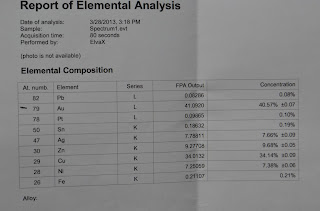Guest Entry by Anya
If you read Yvonne’s entry on Vintage diamonds – OMCs (Old
Mine Cuts) and OECs (Old European Cuts) – you will have noticed that she called
them the only “truly rare” diamonds on the market today. That is because
diamonds with this type of cut are no longer mass produced. Old-cut aficionados
like me have to get creative to find the perfect stone. Here are some tips on how to go about it.
There are several places one can look for a vintage diamond.
Some vendors specialize in selling old stones, such as Jewels By Erica Grace and Old
World Diamonds. Then there are vendors who specialize in cutting modern,
perfected versions of OMCs and OECs, such as the people at Good Old Gold; but newly cut vintage-style stones are usually sold
at a premium. Old cuts can also be found in estate and vintage jewelry shops,
though nice stones are usually few and far in between. Lastly, an educated
buyer can try her luck on eBay.
Buying through eBay has its risks and rewards. It’s risky
because most sellers are not very good at taking photos of their diamonds, the
color and clarity grades are often overestimated, and the return policies aren’t
always straightforward. But the reward
is finding a really good deal on a nice stone, if you know how to look.
In my case, I wanted to find an OEC that would be at least
7mm in diameter, one that would face-up white (most OECs available today tend
to be on the warmer side, probably because the whiter stones were re-cut into
Modern Round Brilliants), eye-clean (anywhere from VS2-SI2), and with the
classic OEC characteristics of a small table, high crown, open culet and neat
kozibe effect (when the open culet reflects around the center of the diamond).
Lastly, I wanted classic OEC faceting that creates a flower or snowflake-like
pattern in the center, and beautiful petal-like facets on the periphery. And
all of this on a tight budget!
After weeks of searching, I found a potential candidate. The
photos weren’t great, most of them taken at an angle and with a flash. But the
description read well, there was a lab appraisal (you can’t really trust the
specs from an appraisal, but it’s a good start) that indicated that the stone
met my requirements. Most importantly, the seller was willing to give me a
several-day inspection and return period.
When I received the stone, I checked for several
characteristics. The most important thing is how well a diamond is cut. I looked for any outright negative optic
qualities, like the much-dreaded fisheye effect (usually seen in shallow
stones, this is when a reflection of the girdle is visible inside the stone,
creating a kind of hazy circle, or “fish eye,” around the table) or nailhead
(when the central facets are dark and have no light play). Then I checked for
general “wonkiness” or poor symmetry. Lastly, I used my 30x loupe to go over
the diamond (which was set into a ring) as closely as possible to check for
chips or cracks.
Once those were ruled out and I was comfortable with the
quality of the diamond’s cut, I concentrated on the color. The appraisal stated
the stone was K-L. Having seen OECs in whiter and lower colors, I judged the appraisal
to be close to accurate. Just to be
safe, I thought maybe the stone could be a bit lower – perhaps L-M as opposed
to K-L. OECs are known for facing up white in settings.
Once I decided that I would keep the ring, I immediately
shipped it to Yvonne so she could run it by the guys in the NYC diamond
district. The stone needed to be unset, polished (to clean up the tiny nicks on
girdle after years of wear and tear), and set into a new setting. A great big
thanks to Yvonne for helping me out with this! Not every eBayer has this kind
access to the professionals in the diamond district.
 |
| eBay Photo of Anya's Ring |
When the stone was loose, it was weighed, and turned out to
be quite a bit lighter than the appraisal estimated. The estimated weight was
1.85ct, but the real weight only 1.78ct. Polishing the stone took a few points
off, so the final weight clocked in at 1.75ct, and around 7.5mm in diameter. A
pretty good size for me!
An additional step I could have taken at this point was to
send the diamond to get graded by one of the major labs. A GIA certificate
would have been great, but it takes at least three weeks and I was impatient to
have the ring on my finger, so the stone remains un-certified for now. If I
ever should want to sell this stone, a cert will definitely be a must. A GIA cert would be best, since that’s the
most trusted laboratory for diamonds.
Another thank you to Yvonne for setting the
stone into my favorite 6-prong yellow gold setting, and shipping it back to me.
I now have it on my finger, and can’t stop admiring it!
 |
| The Finished Product |
.JPG)




